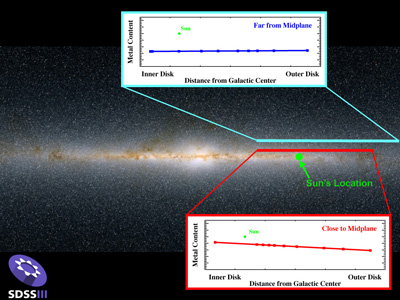Some stars have orbits that take them to interesting places, and they have interesting stories to tell about how they were formed.
For more than a decade, the Sloan Digital Sky Survey (SDSS) has been mapping the stars in our galaxy. At the American Astronomical Society meeting this week in Austin, Texas, UC Santa Cruz astronomers Judy Cheng and Connie Rockosi presented new evidence that will help answer long-standing questions about the history of the stars in the disk of our galaxy.
These SDSS results come from the Sloan Extension for Galactic Understanding and Exploration 2 (SEGUE-2) in the SDSS-III project, which has measured the motions and chemical compositions of more than 118,000 stars. Some of those stars are in the disk of our galaxy, which is what we see as the bright band of stars in the night sky that we call the Milky Way. Stars in the disk orbit around the center of the galaxy. Most of the orbits line up in a flat plane like planets around the Sun, but a few stars orbit to the beat of a different drummer.
"Some disk stars have orbits that take them far above and below the plane of the Milky Way," said Connie Rockosi, associate professor of astronomy and astrophysics at UCSC and principal investigator for the SEGUE-2 survey. "We want to understand what kinds of stars those are, where they came from, and how they got there."
The orbits of these stars make them clearly different from mainstream Milky Way stars, but new research shows that their chemical composition also makes them unique. A team led by UCSC graduate student Judy Cheng studied the amount of metals in such stars at different locations in the galaxy. By making these measurements, Cheng's team was able to look back in time at how the Milky Way disk grew.
The first generation of stars consisted entirely of hydrogen and helium. Over time, those early stars turned some of their hydrogen and helium into heavier elements, like calcium or iron, and when those stars died, the heavier elements they produced became part of the next generation of stars. As new stars were born and the Milky Way disk grew, each generation had more calcium, iron, and other heavy elements (which astronomers refer to as metals). Thus, we can learn which parts of our galaxy have seen several generations of stars come and go, simply by looking at the metal content of stars in that part of the galaxy.
Cheng's team surveyed the metal content of thousands of stars in the disk. Near the plane of the galactic disk--home of the ordinary disk stars--stars closer to the center of the galaxy have higher metal content than those farther from the galactic center. "That tells us that the outer disk of our Galaxy has formed fewer generations of stars than the inner disk, meaning that the Milky Way disk grew from the inside out," said Cheng.
But then Cheng studied the "different drummer" stars, those that are clearly part of the Milky Way disk but show up far above or below the disk plane. She found that the amount of heavier elements in those stars doesn't follow the same trend. Everywhere she looked in that part of the galaxy, stars had low metal content. "The fact that the metal content of those stars is the same everywhere is a new piece of evidence that can help us figure out how they got to be so far away from the plane," Rockosi says.
The scientists do not yet know whether these stars were born with such strange orbits, or whether something happened in the past to put them on these unique paths. "If these stars were born with these orbits, they were born at the same rate all over the galaxy," Cheng said. "If they were born with regular orbits, then whatever happened to them must have been very efficient at mixing them up and erasing any patterns in the metal content, such as the inside-out trend we see in the plane."
Possible explanations for such efficient mixing include long-ago collisions between our galaxy and its neighbors, or the effect of spiral arms sweeping through the disk. Cheng's observations will help determine whether such major events in the lives of these stars caused them to wander far from their birthplace. Disk stars are observed far from the plane in many other galaxies, so solving the puzzle presented by these stars observed by SDSS will help us understand a basic part of how spiral galaxies like the Milky Way form.
About SDSS-III
Funding for SDSS-III has been provided by the Alfred P. Sloan Foundation, the Participating Institutions, the National Science Foundation, and the U.S. Department of Energy. The SDSS-III web site is www.sdss3.org/.
SDSS-III is managed by the Astrophysical Research Consortium for the Participating Institutions of the SDSS-III Collaboration including the University of Arizona, the Brazilian Participation Group, Brookhaven National Laboratory, University of Cambridge, University of Florida, the French Participation Group, the German Participation Group, the Instituto de Astrofisica de Canarias, the Michigan State/Notre Dame/JINA Participation Group, Johns Hopkins University, Lawrence Berkeley National Laboratory, Max Planck Institute for Astrophysics, New Mexico State University, New York University, Ohio State University, Pennsylvania State University, University of Portsmouth, Princeton University, the Spanish Participation Group, University of Tokyo, University of Utah, Vanderbilt University, University of Virginia, University of Washington, and Yale University.



